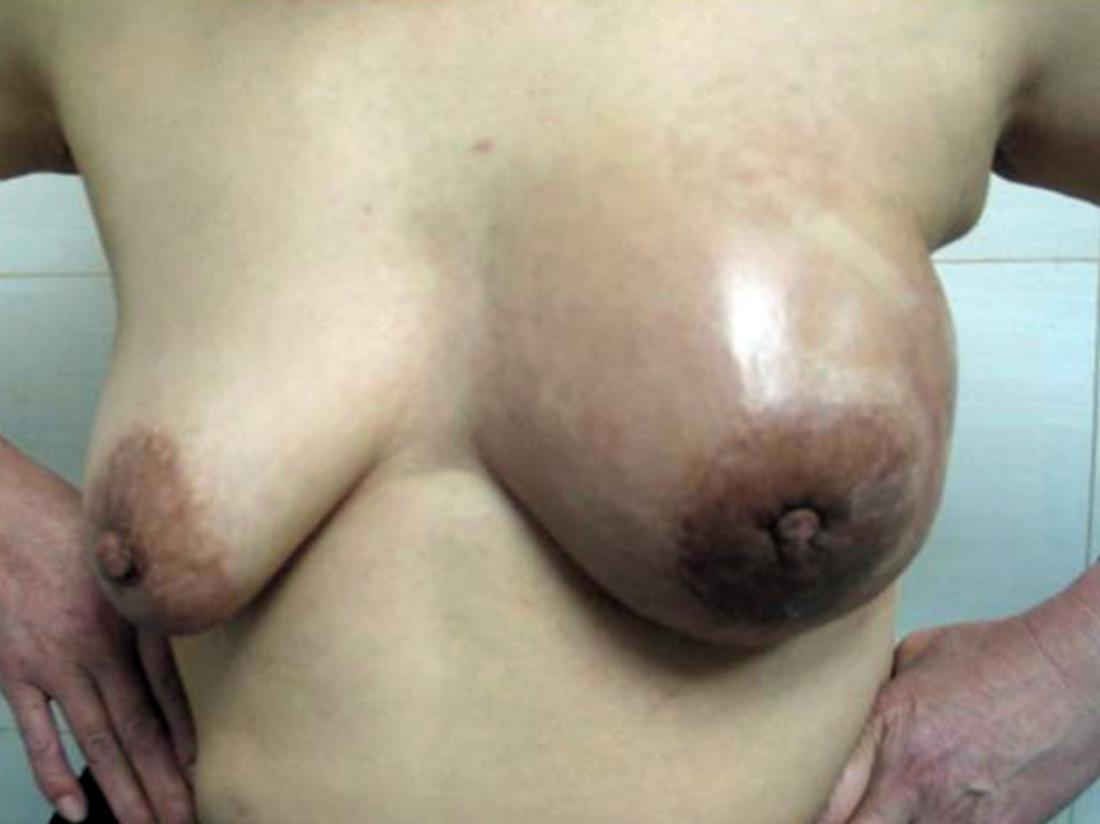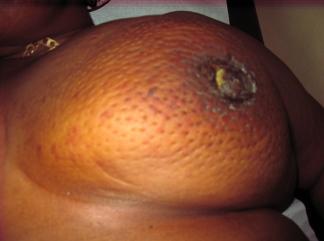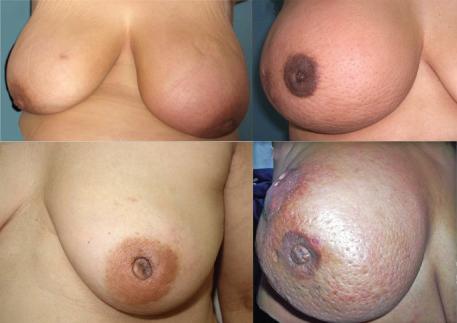According to the National Cancer Institute, inflammatory breast cancer only accounts for 1–5% of all cases of breast cancer that doctors diagnose in the United States.
Keep reading to learn more about the symptoms, treatment, and prognosis of the disease.
Signs and symptoms
Many kinds of breast cancer often begin with a lump in the breast.
Inflammatory breast cancer, however, usually starts with the breast feeling heavy and appearing red and swollen.
Other symptoms of inflammatory breast cancer include:
- redness affecting one-third or more of the breast, which may become more pronounced and then seem to fade
- swelling or rapid growth in the breast
- a breast that feels hard to touch
- noticeable aching, tenderness, or hot feeling in the breast
- a nipple that seems to flatten out or move sideways
- changes to the skin of the breast, such as developing hives or welts or an orange peel texture
Pictures


Image credit: Wang M, Hou L, Chen M et al., 2007.

Image credit:
Pan Afr Med J, 2012

Image credit: Cancer Med, 2013
Differences from other forms of breast cancer and mastitis
The reddish color of the breast that doctors associate with inflammatory breast cancer is one of the main differences between this and other forms of breast cancer.
Other breast cancers usually start with a lump in the breast and have no color change.
However, people sometimes mistake inflammatory breast cancer for another kind of cancer that has progressed significantly at one site.
Mastitis, an infection affecting breastfeeding women, has many of the same symptoms as inflammatory breast cancer.
While mastitis will improve with antibiotics and the redness resolve, inflammatory breast cancer does not improve with antibiotics.
Also, fever is not typical in inflammatory breast cancer but can be a symptom in advanced mastitis.
Learn more about the symptoms of mastitis.
Causes and risk factors
According to the American Cancer Society (ACS), inflammatory breast cancer occurs in people under the age of 40 years old, which is younger than for other forms of breast cancer.
African American females have a higher risk of inflammatory breast cancer than white females.
When to see a doctor

If a person experiences swelling in the breast, they should speak to their doctor.
Because inflammatory breast cancer is so aggressive and invasive, people should see a doctor for evaluation if they notice any persistent changes in their breasts.
Signs that it is time to seek medical care include:
- swelling in the breast
- itching, swelling, heaviness, or redness in the breast
- changes to the skin of the breast that starts to resemble orange peel
- inverted nipple
These symptoms could also indicate an infection, in which case, a doctor may prescribe antibiotics.
Individuals who receive such treatment should monitor their symptoms, and if they do not see improvement within 7–10 days, they should request further tests.
Diagnosis
The first step in diagnosing inflammatory breast cancer is usually a biopsy. A doctor removes some tissue from the breast for examination for signs of cancer.
There are two types of biopsy:
- Skin punch biopsy: Doctors often use this when they suspect inflammatory breast cancer. This approach captures the skin and deeper layers of the breast tissue.
- Core needle biopsy with ultrasound: Using high frequency sound waves, a doctor inserts a hollow needle into the affected breast and removes tissue to test for cancer.
If doctors detect inflammatory breast cancer, they will require more tests to see if cancer has spread. These tests will also determine how far the disease has spread from the original site.
An MRI is particularly helpful for imaging inflammatory breast cancer.
Other tests doctors use to find more information about the status of an individual’s inflammatory breast cancer include:
- chest X-ray
- CT scan or other staging scans, such as PET-CT
- bone scan
- liver function studies
Stages
Similarly to other forms of cancer, doctors classify inflammatory breast cancer according to stages.
Knowing the stage of an individual’s cancer helps healthcare professionals to:
- work with patients to select the best treatment options
- determine the prognosis for the individual
- pick appropriate clinical trials for the person
Doctors determine the stage of an individual’s breast cancer, depending on:
- the size of the tumor
- cancer spreading into tissues near the original tumor
- presence of cancer in the lymph nodes
- spread of cancer outside the breast
- sensitivity of the cancer cells to estrogen and progesterone
- the grade of the tumor
- levels of the HER2 protein
Doctors assess the grade of the tumor from the difference between the cancer cells and healthy cells.
Levels of the HER2 protein are usually higher in tumors from inflammatory breast cancer.
General characteristics of the stages of cancer are as follows:
- 0: There is no evidence that cancer has spread beyond the area of the breast where it started.
- I: Cancer has spread to surrounding breast tissue.
- II: Cancer has spread to the lymph nodes, and the tumors are somewhat larger.
- III: Cancer is present in more lymph nodes or has invaded the chest wall.
- IV: Cancer has spread to other organs in the body.
Inflammatory breast cancer affects the skin as well as the breast tissue. For this reason, doctors classify most cases of the disease as at least stage III at their initial diagnosis.
Learn more about the stages of breast cancer.
Treatment options
Doctors typically treat Inflammatory breast cancer with a multimodal approach.
This means they use a variety of techniques to improve an individual’s chances of survival.
Techniques include:
- systemic chemotherapy to shrink the tumor
- treatment targeting HER2 proteins
- hormone therapy if cancer cells have hormone receptors
- radiation therapy
- additional systemic therapy after surgery
- surgery
Surgery is often a modified radical mastectomy. Doctors do not typically advise reconstruction for inflammatory breast cancer surgery.
Treatment options based on hormones, such as tamoxifen, are rarely helpful with inflammatory breast cancer. This is because tumors from this form of breast cancer usually do not require estrogen to grow, which tamoxifen blocks.
Prognosis

Management of inflammatory breast cancer is improving with new medical treatments.
Inflammatory breast cancer is a very serious disease, but new and improved medical treatments have led to better management of the disease.
However, because the disease is so aggressive and spreads so rapidly, the survival rates for inflammatory breast cancer are lower than other types of breast cancer.
The ACS state that inflammatory breast cancer has already spread to other parts of the body by the time doctors diagnose it in 1 out of every 3 cases of the disease.
For the purpose of estimating survival rates, the ACS refer to inflammatory breast cancer as:
- Localized — meaning the cancer does not appear to have spread outside of the breast.
- Regional — meaning the cancer has spread beyond the breast to tissues that are close by or to the lymph nodes.
- Distant — meaning the cancer has spread to distant areas such as the lungs, liver, or bones.
The ACS advise that the corresponding 5-year survival rates are:
- Regional: 52%
- Distant: 18%
Summary
Inflammatory breast cancer is a rare and aggressive form of breast cancer. The most common symptoms are redness, swelling, itching, and heaviness in one breast.
Because the disease tends to be well advanced before diagnosis, current survival rates for inflammatory breast cancer are not as encouraging as they are for other kinds of cancer.
However, ongoing research and improvements in care can make a difference in treating the disease.
